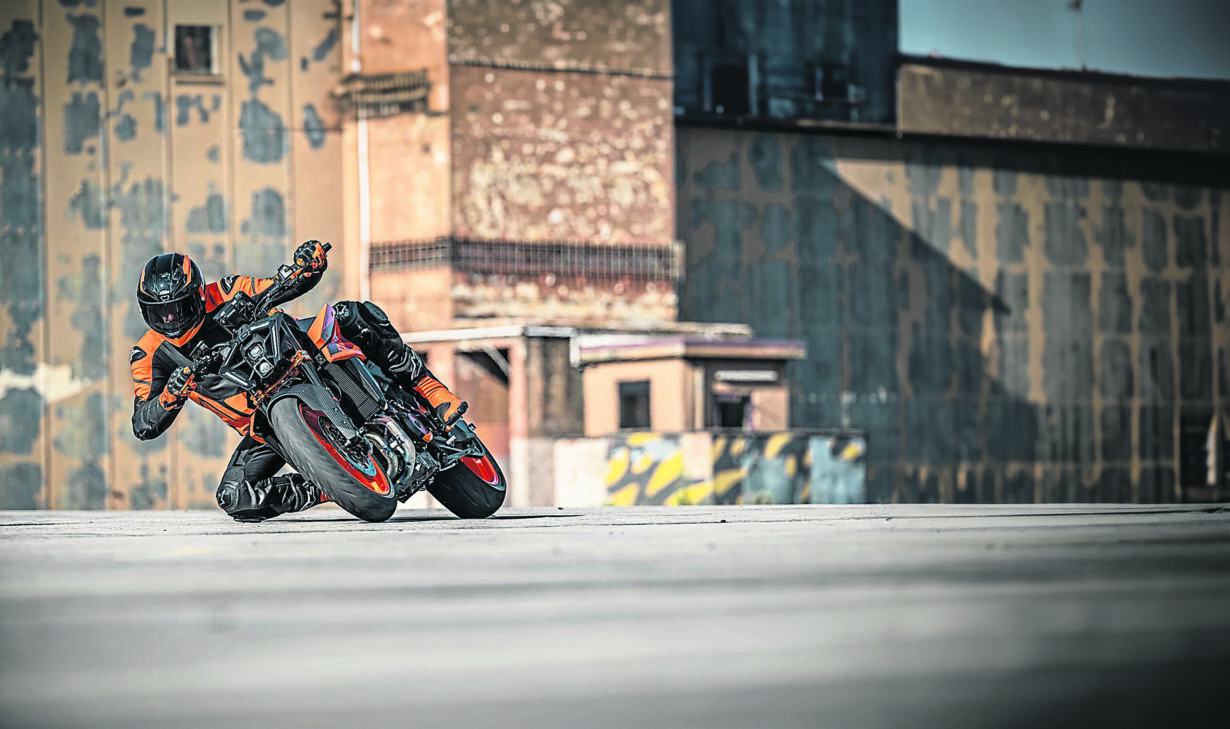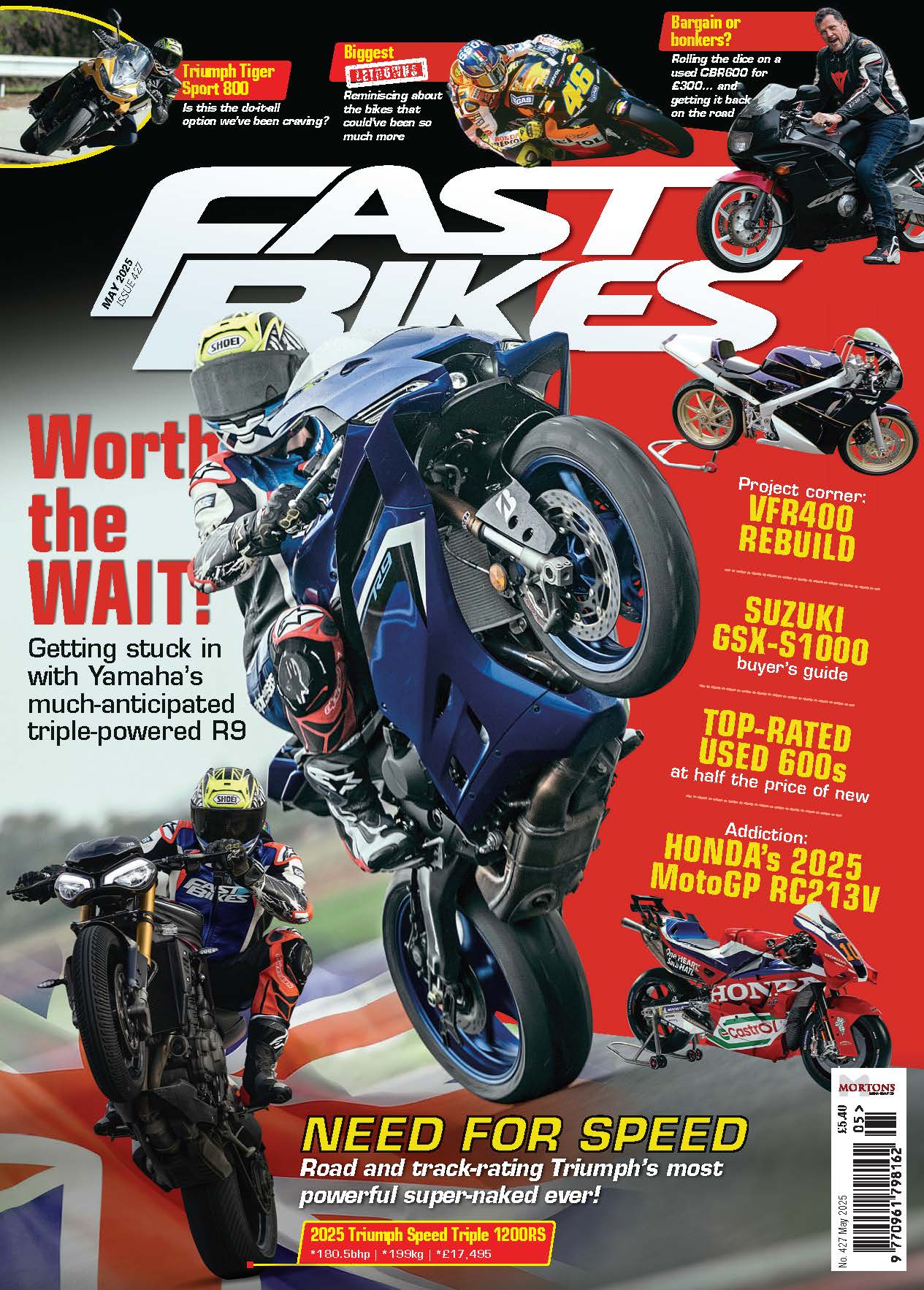We caught up with John McAvoy, who filled us in on the KTM…
It’s been a while since KTM last had a 990 Duke in its range, but the name is back – and this new addition is perhaps one of its most exciting offerings ever. Here’s why…
The 990 gets a brand-new frame that’s 15 per cent stiffer than the 890’s frame (which is a lot) and a brand-new swingarm that’s 1.5kg more than the 890’s (which is also a lot). So, straightaway you can see where KTM is going with the 990 – much stiffer and much lighter than the 890.
The engine is also completely new, without a single carry-over component from the 790/890. In fact, the only thing the engine – and whole bike, for that matter – has got in common with the 790/890 is the fact that it’s a parallel twin… and the brakes. The engine is good for 123bhp and 76lb-ft of torque, which is the same as a Ducati Streetfighter V2, so just like with the 1390, KTM is focusing on big dollops of torque rather than absolute peak power. For context, the 990 Duke is punching out the same torque as a Ducati 999, which really does cut it from the same cloth as the Super Duke, rather than a big version of the 390 Duke.

Physically, the 990 is basically a slightly smaller 1390. The fuel tank is wider, and the exhaust silencer is routed more conventionally to the side rather than the strangely shaped underseat one on the 890. The headlight looks like the 1390’s because… well… it is the same, along with the front wheel and dashboard. It’s also loaded with pretty much all the 1390’s electronics (if you pay the extra for them). You get five rider modes; nine-way adjustable traction control; five-way adjustable anti-wheelie; lap timer; launch control; cruise control; adjustable engine slip; telemetry; and Bluetooth connectivity. The 990 pretty much gets the whole shooting match when it comes to tech. It also gets adjustable for rebound and compression damping 43mm WP Apex forks up front, and a WP Apex rear shock that’s adjustable for preload and rebound damping.
The whole thing cashes in at 179kg fully fuelled, so in terms of spec on the dyno sheet, tech list, and weighing scales, the 990 is basically the gold standard in the middleweight naked class, which, considering KTM basically had no representation in it until now, is impressive –and that form carries over into how it feels on the road.
The 120(-ish)-mile road ride we did on the 990 will remain with me for a long, long time. The combination of the route, the roads, and, of course, the bike was literally perfect. Most of it was in second, third or fourth gear, with the occasional obligatory first gear 10mph hairpin thrown in and more than a handful of tapped out in sixth gear straights. This road might as well have been made with the 990 in mind: it was smooth, traffic-free, and required pretty much constant manoeuvring of the bike, which was a complete doddle due to the KTM’s brilliant riding position, geometry, light weight, and very high-quality suspension – especially the forks.
If I have one very small mark to make against the 990’s chassis, it’s that the brakes aren’t very easy to modulate. The distance between the initial touch of the lever and the brakes being on quite hard is very small, but it’s not a big problem and is pretty much the only non-perfect thing I noticed about the 990.
The whole thing feels completely different to the 790/890; there is no resemblance to its predecessors. It feels so much more planted to the ground and is so much more alive with feedback and information that you can’t help but feel your confidence grow with every kilometre you spend on it. The 990 has done to the middleweight naked class what the 1390 does in the supernaked class – it delivers big on performance, but also very big on fun, and it does this by making it easy to ride and to access all of what it has to offer. It simply oozes all the hallmarks of a bike that has been developed by a team of engineers, suspension specialists and test riders who all know what the best bits about riding motorbikes are. They’re all on the same page as us, and just like the 1390, the 990 has the same feeling of completeness that very well set up race bikes have, everything just… works.
The engine is unsurprisingly brilliant on the road, and if we don’t see an RC990 sportsbike with the Duke’s engine on the road next year, I’ll be amazed – and I’ll fight anyone for a go on it when it does show up. However, as we know, an engine must be more than impressive numbers on a dyno chart; it has to be connected to the throttle in such a way that getting the best out of it is easy. The ‘street’ map was on the money for the areas of the rev range that we were using mostly, which was, of course, the 990’s sweet spot, sitting on a big lump of torque, punching out of the endless corners. I did find the gearshift a little bit stiff, but like my comments on the brakes, it’s just something I noticed.
On the road, the 990 will be hard to live with by its rivals. Set aside the fact it has got far superior tech than all of them, and more of it, the basic ingredients of the 990 are all on the money. KTM has made a stiff, lightweight naked bike with a punchy motor and finished it off with some very sporty geometry and high-quality suspension. KTM has taken a lot – if not all – of its learning from the evolution of the Super Duke and poured it into the 990 Duke, and it really shows. The 990 is impossible to ride and not enjoy, and anyone who rides one and says they didn’t enjoy it is a liar.




